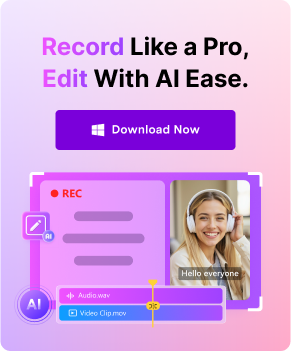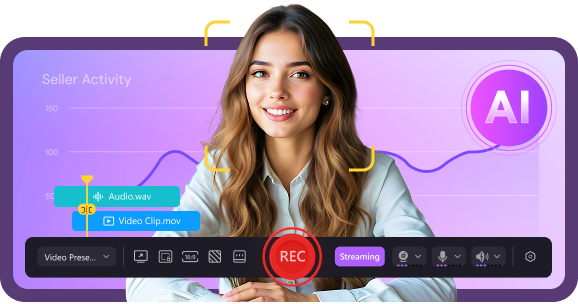Nowadays, everyone wants top-notch instructional videos. It does not matter if you are a teacher, a business coach, or someone who makes content. Knowing how to make educational videos that catch people's attention is key. This guide is here to help you learn how. It covers the basics of making instructional videos. This includes planning and editing steps. So, you can create content that really speaks to people.
Key Takeaways
- Understand the significance of engaging educational video production.
- Learn the steps involved in planning your instructional video content.
- Discover the right tools for recording high-quality videos.
- Explore best practices for recording and editing videos.
- Identify the best platforms for sharing your instructional videos.
In this article
- Planning Your Instructional Video Content
- Selecting the Right Recording Tools
- Wondershare DemoCreator: Best Practices to Record Your Video
- Editing Your Instructional Videos
- Engaging Your Audience
- Best Platforms for Sharing Instructional Videos
- Creating Content for Different Learning Styles
- Measuring the Effectiveness of Your Videos
Part 1: What do You Know about Instructional Videos?
Instructional videos are digital clips that aim to teach about specific topics. They make learning easier by simplifying hard subjects into smaller, attractive parts. This section talks about the definition of instructional videos, why they matter, and the many benefits of educational videos.

What Are Instructional Videos?
These videos use pictures and sound to share knowledge or teach a skill. They are more lively and engaging than just words on a page. This makes it easier to understand and remember the information.
Importance of Engaging Instructional Videos
Good instructional videos keep viewers interested, making learning more interactive and fun. They tell stories, use striking visuals, and sometimes add quizzes. These methods help make learning not just more enjoyable but also more effective.
Benefits of Creating Instructional Videos
There are many benefits of creating instructional videos. They explain tough concepts more clearly and let students learn at their speed. Videos help people remember info better. They can reach learners worldwide, which is great for teaching in different places.
Part 2: Planning Your Instructional Video Content
Start by knowing your audience and what they need. Make content that fits them well. This makes your video valuable.
Defining Your Audience
Learn about your viewers' age, likes, and problems. This helps decide how to talk and what to cover in your video.
Setting Learning Objectives
Your video needs clear goals. Think about what you want to achieve. This helps track if the video teaches well.
Developing a Script and Storyboard
Plan your video to keep it interesting. Write down what to say and show. This makes your story clear and engaging.
- Research to know your audience.
- Have clear goals for learning.
- Write a script and plan visuals for a smooth video.
Do these steps for great instructional videos. They will connect with viewers and improve learning.
Part 3: Selecting the Right Recording Tools

Choosing the right recording tools is crucial. They ensure your content is clear and engaging. It's key to use the best equipment.
Best Cameras for Instructional Videos
A high-definition camera is vital for clear visuals in videos. The Canon EOS M50 is excellent for video. The Sony Alpha A6400 has great autofocus capabilities.
Using Screen Recording Software
Reliable screen recording tools are vital for instructional videos. Wondershare DemoCreator lets you capture screen and webcam footage. Camtasia and OBS Studio also offer great features.
Choosing the Right Microphone
Audio quality is very important in videos. Choose the best microphones for clear sound. The Blue Yeti USB Microphone and Rode NT-USB are top choices. They provide superior audio clarity and are easy to use.
| Equipment | Key Feature |
| Canon EOS M50 | High-definition video performance |
| Sony Alpha A6400 | Advanced autofocus capabilities |
| DemoCreator | Screen and webcam recording |
| Blue Yeti USB Microphone | Superior audio clarity |
| Rode NT-USB | User-friendly interface |
Investing in the right video equipment, recording tools, and microphones is key for engaging content.
Part 4: Wondershare DemoCreator: Best Practices to Record Your Video

Wondershare DemoCreator is a screen recorder and video editor. It's great for educators and trainers. It helps make instructional content engaging.
Overview of DemoCreator Features
Wondershare DemoCreator has many features to improve video making:
- Multi-Track Recording: Record your screen, audio, and webcam at the same time. This makes tutorials more detailed.
- Rich Visual Assets: Use different annotations, transitions, and effects. They make your videos more lively.
- AI-Powered Editing: Editing is easy and smart with AI technology. It makes editing simpler.
- Customizable Recording Settings: Adjust frame rates, resolutions, and audio to fit your needs. This makes recordings perfect for you.
Benefits of Using DemoCreator
Using Wondershare DemoCreator for screen recording has many benefits:
- Ease of Use: Its interface is simple. This makes it good for all users, new or experienced.
- Versatility: Make all kinds of educational videos, like lessons or software demos. It's very flexible.
- Powerful Editing Tools: Improve your videos with great editing tools. Your educational videos will be more engaging and effective.
Wondershare DemoCreator is a top choice in video creation for education. It's feature-rich and designed for users. It makes creating quality content easy.
Best Practices to Record Your Video
1. Tips for High-Quality Recordings
First, find a place with good light to make your videos look great. It's important to keep your camera steady. Using tripods can help stop shaky footage. Here are some top video recording tips:
- Use natural or soft lighting to avoid strong shadows.
- Choose a simple, neat background.
- Always check your camera settings for the clearest picture and frame rate.
2. Using a Virtual Avatar
Using virtual avatars in videos can make your videos more engaging. Tools like Wondershare DemoCreator let you create custom avatars. This means you don't have to be on screen. Avatars can make your videos more fun. They also help show your message clearly.
3. Recording Audio Efficiently
For a top instructional video, great audio is a must. Here are some efficient audio recording tips:
- Use tools to cut down on background noise.
- Keep your microphone close, about 6-12 inches away.
- Check that your audio is clear before you finish setting up.
Following these tips will help you make videos that teach well and keep people watching.
Part 5: Editing Your Instructional Videos
Learning to edit well can boost your instructional videos. Using the right tricks makes your content fun and helpful.
Basic Editing Techniques
Start with key video editing tips like cutting and merging clips. These steps help your video flow well and keep viewers interested. By trimming the fat and keeping the good parts, your video gets better.
Using Templates and Effects
Using ready-made templates and cool instructional video effects can make your videos look great. Templates make your work seem pro while saving time. Effects like transitions make your video more exciting. These bits help viewers remember your info better.
Enhancing Videos with Annotations and Transitions
Video annotations and smooth transitions are key. They make important points pop and keep your video easy to watch. Annotations draw attention to the must-know bits, and transitions link your ideas nicely. This mix makes your instructional video both engaging and clear.
Incorporating Visual and Audio Elements
Using visual aids in videos is key for engaging, effective learning. Visuals like diagrams, charts, and animations can simplify hard concepts. They make it easier for viewers to get the idea.
Also, adding background music and sound effects can boost the learning journey. These audio enhancements in educational videos help in focusing. They make the content stick in your mind. Pick audio that matches the visuals and aids learning goals.
Checkout this table to understand how to use visuals and sounds better:
| Element | Description | Benefits |
| Diagrams | Visual representations of data and information | Clarifies complex concepts |
| Charts | Graphical representation of numeric data | Enhances data visualization |
| Animations | Moving graphics to illustrate processes and concepts | Makes learning engaging and dynamic |
| Background Music | Music played softly in the background | Enhances mood and concentration |
| Sound Effects | Specific sounds highlighting key points | Improves retention and impact |
Mixing visual aids in videos with audio enhancements in educational videos lets teachers create captivating, effective videos.
Part 6: Engaging Your Audience

To make your instructional videos more exciting, you must use techniques that grab attention. Adding elements that invite participation makes your content more fun and understandable. This way, everyone can enjoy and learn from it.
Interactive Elements in Videos
Adding interactive parts to instructional videos makes learning more fun. You can help viewers learn by asking them to click links, take quizzes, or vote in polls. This keeps them involved and helps them remember what they learned.
“Interactive elements like quizzes can increase viewer retention by fostering a more immersive learning environment.”
By using interactive features wisely in your videos, you can simplify tricky topics. This keeps your audience focused and eager to learn.
Using Captions and Subtitles
It's important to add video captions and subtitles. They make sure that everyone, including people who are deaf or don't speak the language, can understand your videos. This way, no one misses out on the learning.
Captions also help people remember what they watch better. They reinforce the information, making it easier to remember. Plus, having subtitles in different languages means more people across the world can learn from you.
- Boosts accessibility for viewers with hearing impairments.
- Improves comprehension for non-native speakers.
- Reinforces information through visual and auditory means.
Part 7: Best Platforms for Sharing Instructional Videos
Choosing the right spot for your instructional videos is key. Sites like YouTube, Vimeo, and educational ones like Udemy and Coursera have tools and people for all needs.
When picking where to upload instructional videos, look at what the site offers. YouTube has a big audience, while Vimeo feels more professional.
| Platform | Key Features | Audience |
| YouTube | Wide reach, Free to use, Ads monetization | General public, all age groups |
| Vimeo | High-quality videos, No ads, Privacy controls | Creative professionals, business users |
| Udemy | Course creation tools, Monetization options | Students, continuous learners |
| Coursera | Accredited courses, Structured learning | Academic learners, professionals seeking certification |
Know what each video sharing platform offers. It helps educators and creators decide where to upload instructional videos. This way, they reach more people and have a bigger impact.
Part 8: Creating Content for Different Learning Styles

When making instructional videos, it's key to match content with various learning styles. This ensures everyone stays engaged and learns well. Here’s how to make videos that reach different types of learners:
Visual Learners
Visual learners understand best with clear visuals. Use charts, graphs, and animations in your videos. This helps their visual learning.
Adding engaging infographics and bullet points also strengthens key ideas.
Auditory Learners
Auditory learners do well with great audio and spoken explanations. Your videos should have clear voice-overs and extra audio cues. Adding soft background music that fits the content also helps a lot.
Kinesthetic Learners
Kinesthetic learners love to be hands-on. Include demos or simulations in your videos that call for interaction. For example, hands-on tutorials where learners can actively participate work well.
Below is a summary to help create effective videos for all learning styles:
| Learning Style | Effective Video Elements |
| Visual Learners | Animations, charts, infographics, bullet points |
| Auditory Learners | Clear voice-overs, supplementary audio cues, background music |
| Kinesthetic Learners | Interactive demonstrations, simulations, real-time tutorials |
By carefully adding these parts, you can make videos that cater to everyone. This makes your content both engaging and easy to access for all learners.
Part 9: Measuring the Effectiveness of Your Videos
To make sure your instructional videos hit the mark, measuring their impact is key. You can do this by looking at video engagement metrics. Also, by getting instructional video feedback from your viewers.
Analyzing Viewer Engagement Metrics
Understanding how viewers engage with your videos is important. You should keep an eye on several key metrics:
- Watch Time: The total time viewers spend watching your videos.
- Viewer Retention: The percentage of viewers who watch your video from start to finish.
- Interaction Rates: Counts the likes, shares, and comments each video gets.
By checking these metrics, you can see what's working and what's not. This way, you can make your videos more interesting to your viewers.
Gathering Feedback and Making Improvements
Getting feedback on your videos is also crucial. Use surveys, polls, or comments to hear what viewers think. Their opinions and ideas can show you what's good and what needs work.
| Feedback Method | Purpose | Frequency |
| Surveys | Collect structured responses on video quality and content | Post-video |
| Polls | Gather quick opinions on specific aspects | During or after video |
| Comment Sections | Facilitate open discussions and real-time reactions | Throughout video availability |
By using viewer feedback well, you can keep your videos fresh and useful. This ongoing process helps make your educational materials more effective and engaging over time.
Conclusion
Making great instructional videos takes a lot of steps. You need good planning, the right tools, and to follow best practices for recording and editing. We've talked about what's needed to make educational videos that work well. This includes knowing your audience, having clear goals, and picking the right equipment. Every step is important for your video's success.
But there's more to it than just making the video. To keep your audience interested, use interactive elements, captions, and visual aids. It's also vital to meet the needs of different learners, like those who learn by seeing, hearing, or doing. This way, your videos will help and interest a wide range of viewers.
Don't forget to always check how your videos are doing. Look at how much people watch them and listen to their feedback. This will tell you what to change to make your videos better. In short, good planning, doing, and improving are key. They help you make educational videos that don't just share knowledge but also keep viewers coming back for more.
FAQs
-
Why is it important to make engaging instructional videos?
Engaging videos hold viewers' attention, boosting learning. They make hard ideas clear, make learning flexible, and help remember facts. This ensures learning goals are met well.
-
What are the best cameras for recording instructional videos?
Use HD cameras, like DSLRs from Canon or mirrorless from Sony. They give clear, professional video, important for making compelling educational content.
-
How can I ensure high-quality recordings for my instructional videos?
Film in well-lit places, keep the camera steady, and place mics right for clear sound. Using avatars adds a personal touch without you being on camera.
-
What are some basic editing techniques for instructional videos?
Use basic editing like cutting, cropping, and merging. Adding effects and using templates make your videos look better and more engaging.



